


|
Four Star & Five Quality
|

|
Members on this page offer B&B accommodation in and around:
Oban (5) - Loch Lomond (3) - Helensburgh (1) - Dunoon (1) - Isle of Arran (1)
Please note that double/twin room prices are per person per night based on two persons sharing. To make enquiries or bookings, please contact the proprietor direct via phone, fax or email as detailed on the relevant entry. If you are outside the UK, first dial the appropriate international dialing code for your country (011 from the States for example), then dial 44 and omit the initial 0 of the number given in these pages, before dialing the remaining digits.
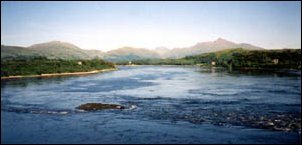
Loch EtiveThe road south along Loch Linnhe, leads to Oban, a popular tourist destination set in magnificent scenery and with good access to Loch Awe, Loch Etive and Loch Fyne. Oban is the starting point for ferries to several islands, including Mull.
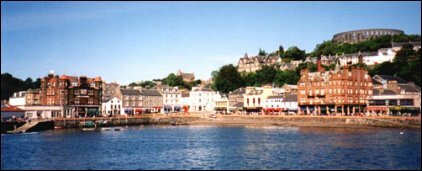
The harbour at ObanMull's main centre, Tobermory, is set around the bay, lined by colourful 18th century houses. A Spanish Galleon, the Florencia, part of the Armada fleet, put into the bay after the destruction of the Armada in 1588. The galleon blew up, or was blown up by treachery, and sank with the loss of 350 men. Her reputed cargo of treasure sank with her and has never been recovered despite many attempts.
From Oban the road winds south through Lochgilphead, along Loch Fyne and then down to Campbeltown, almost at the tip of the Kintyre peninsula. Near the head of Loch Fyne is the imposing Inveraray Castle, not far past Crarae Gardens famous for its rhododendrons and azaleas. Throughout this area are numerous well known gardens in addition to Crarae: Arduaine; Younger Botanic Gardens; Ardmaddy Castle; Kilmory Woodland Park and others.
East of Oban, after Connel, the road leads through the Pass of Brander then past Kilchurn Castle at the head of Loch Awe. Turn south at Tyndrum, and then at Crianlarich, towards Loch Lomond and its 'Bonny Banks'. This area is Scotland's first National Park with a new visitor centre on the banks of the loch.
A few miles from Loch Lomond on the north side of the Clyde estuary with lovely views is Helensburgh, birthplace of John Logie Baird, inventor of television. On the line of the 350 million year old Highland Boundary Fault, Helensburgh is technically in the Lowlands although just a short distance away are the much older rocks of the Highlands. Hill House, designed by the renowned Glasgow architect Charles Rennie Mackintosh and built in 1902-3, is open to the public. More of Mackintosh's work can be seen in Glasgow itself - the Willow Tearooms on Sauchiehall Street and the Art School on Garnet Hill for example.
Only a short trip from Glasgow is the Isle of Bute. This picturesque island is about 15 miles long and less than 5 miles wide. Once a popular holiday destination during Victorian times, Bute still has much to offer with hills in the north, lots of sandy beaches, ruined chapels and forts, yachting, fishing, golf, etc. The gardens here benefit from the Gulf Stream which gives the island a mild climate enabling palm trees and other exotic plants to grow here. One of the main visitor attractions is the spectacular Mount Stuart House with its Gothic architecture and sumptuous interiors.
Further south down the coast of Ayrshire, with views across to Bute and Kintyre, is Ardrossan from where the ferry leaves for the Isle of Arran. Despite its small area (about 20 miles x 10 miles), the island is considered as 'Scotland in miniature' for its variety of scenery and sights. These include Brodick castle, a distillery, forests, mountains, waterfalls, beaches, standing stones, etc. Arran's highest point is Goat Fell at 2866 feet high.
ROINEABHAL COUNTRY HOUSE
Roger & Maria Soep
Kilchrenan - By Taynuilt - Argyll PA35 1HD
Tel: 01866 833207 / Fax: 01866 833477
Email:
Click to view web site with more details & photos
|
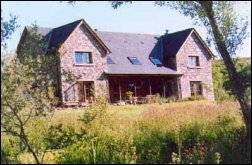 |
AROS ARD
Liz & Patrick MacLean
Croft Road - Oban PA34 5JN
Tel: 01631 565500
Email:
|
 |
INVERCAIRN
Mrs Margaret MacPherson
Musdale Road - Kilmore - By Oban PA34 4XX
Tel/Fax: 01631 770301
Email:
Click to view web site with more details & photos
|
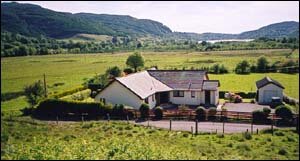 |
LA CALA
Mrs Mairi Jackson
Ganavan Road - Oban PA34 5TU
Tel: / Fax: 01631 562741
Email:
Click to view web site with more details & photos
|
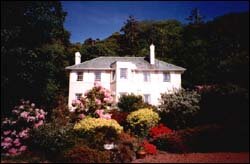 |
BLARCREEN HOUSE
Shelley & Steve Perkins
Ardchattan - By Oban PA37 1RG
Tel: 01631 750272 / Fax: 01631 750132
E-mail:
Click to view web site with more details & photos
|
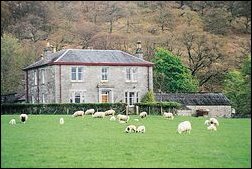 |
LOMOND VIEW COUNTRY HOUSE
Grace & George Brown
Tarbet - Loch Lomond G83 7DG
Tel: / Fax: 01301 702 477
Email:
Click to view web site with more details & photos
|
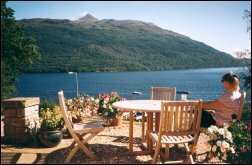 |
ARDOCH COTTAGE
Mabel and Paul Lindsay
Main Street - Gartocharn - Loch Lomond G83 8NE
Tel: 01389 830452 / Fax: 01389 830452
Email:
Click to view web site with more details & photos
|
 |
WATERS EDGE COTTAGE
Colleen & Donald Robertson
Duck Bay - Arden - Luss - Loch Lomond G33 8QZ
Tel: 01389 850629
Email:
Click to view web site with more details & photos
|
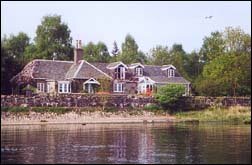 |
LETHAMHILL
Jane and Douglas Johnston
20 West Dhuhill Drive - Helensburgh G84 9AW
Tel: 01436 676016 / Fax: 01436 676016
E-mail:
Click to view web site with more details & photos
|
 |
BELMONT HOUSE
Daphne & Graham Perks
2 Edward Street - Dunoon PA23 7JF
Tel: 01369 701287
E-mail:
Click to view web site with more details & photos
|
 |
THE SHORE
Alison Thompson
Lamlash - Isle of Arran KA27 8JY
Tel / Fax: 01770 600764
E-mail:
Click to view web site with more details & photos
|
 |

To make enquiries or bookings, please contact the proprietor direct via phone, fax or email as detailed on the relevant entry. If you are outside the UK, first dial the appropriate international dialing code for your country (011 from the States for example), then dial 44 and omit the initial 0 of the number given in these pages, before dialing the remaining digits.
Practical information including currency exchange rates, transport, driving times, maps, weather, etc. is provided to assist you on our travel info page.
This web site also has B&B listings in:
Edinburgh, Lothian and Borders - Fife, Angus & Stirling - Perthshire & The Trossachs
Aberdeen & Grampian Highlands - Inverness, Loch Ness and Nairn
Northern Highlands & Orkney - West Highlands & Skye - Aviemore & the Cairngorms
Greater Glasgow, Ayrshire, Dumfries & Galloway
Please note that all details of establishments are as provided by the proprietors
who are solely responsible for the standards of their establishments
and for the accuracy of information displayed on this web site concerning them.
November 2004
www.scotlandsbestbandbs.co.uk/argyll.htm
Site designed by The Internet Guide to Scotland
Hits:



























